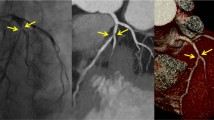Abstract
Background: The aim of this study was to present an original technique of low-dose coronary computerized tomographyangiography (CCTA) for the evaluation and early diagnosis of coronary occlusive disease (COD) and to compare from this technique of CCTA with those resulting from the latest conventional angiography and multidetector computerized tomography units. Methodology: The study included 820 CCTA exams of patients with COD (average age 61 +/− 7 years), with a follow-up exam in 204 male (39%) and 62 female (20%) patients with hemodynamically insignificant coronary occlusion. Exams were performed using a 64-slice computerized tomography (CT) unit using electrocardiography (ECG)-triggering and individual settings (voltage of the x-ray tube and effective tube-current) based on each patient’s body mass index. Exponential dose for each exam was defined. Results:There was a statistically significant progression in the number of patients in whom occlusion of one of 3 coronary arteries occurred in hemodynamically significant occlusive disease (occlusion of more than 50% of lumen) — 60 of 204 males and 12 of 62 females (p<0.0001 and p<0.001). The mid-effective radiation dose during CCTA exams was 1.9+/-0.7mSv (range of 0.9 to 3.9 mSv). Conclusion: Prospective ECG-triggering allowed for low-dose CCTA exams while still enabling high diagnostic accuracy in evaluating patients with COD. The technique used in this study resulted in 2 times less the exponential dose than conventional angiography.
Similar content being viewed by others
References
Brenner, D.J.; Elliston, C.D., Hall, E.J. & Berdon, W.E. Estimated risks of radiationinduced fatal cancer from pediatric CT. American Journal of Roentgenology, 2001; 176(2): 289–296
de Gonzalez, A. B. & Darby, S. Risk of cancer from diagnostic X-rays: estimates for the UK and 14 other countries. Lancet, 2004; 363(9406):345–351
Einstein AJ, Henzlova MJ, Rajagopalan S. Estimating risk of cancer associated with radiation exposure from 64-slice computed tomography coronary angiography. JAMA 2007;298:317–323.
Schroeder S, Achenbach S, Bengel F, et al. Cardiac computed tomography: indications, applications, limitations, and training requirements: report of a Writing Group deployed by the Working Group Nuclear Cardiology and Cardiac CT of the European Society of Cardiology and the European Council of Nuclear Cardiology. Eur Heart J 2008;29:531–556.
Lovic D et al, Prevalence of arterial hypertension in Serbia: PAHIS study. J Hypertens. 2013;31(11):2151–2157
Herzog BA, Husmann L, Burkhard N, et al. Accuracy of low-dose computed tomography coronary angiography using prospective electrocardiogram-triggering: first clinical experience. Eur Heart J 2008; 29:3037–3042.
Hsieh J, Londt J, Vass M, Li J, Tang X, Okerlund D. Step-and-shoot data acquisition and reconstruction for cardiac x-ray computed tomography. Med Phys 2006;33:4236–4248.
Husmann L, Valenta I, Kaufmann PA. Coronary angiography with low-dose computed tomography at 1.4 mSv. Herz 2008;33:75.
Herzog BA, Husmann L, Burkhard N, et al. Lowdose CT coronary angiography using prospective ECG-triggering: impact of mean heart rate and heart rate variability on image quality. Acad Radiol 2009;16:15–21.
Miller JM, Rochitte CE, Dewey M, et al. Diagnostic performance of coronary angiography by 64-row CT. N Engl J Med 2008;359: 2324–2336.
Pazhenkottil AP, Husmann L, Buechel RR, et al. Validation of a new contrast material protocol adapted to body surface area for optimized lowdose CT coronary angiography with prospective ECG-triggering. Int J Cardiovasc Imaging 2010;26:591–597.
Austen WG, Edwards JE, Frye RL, et al. A reporting system on patients evaluated for coronary artery disease. Report of the Ad Hoc Committee for Grading of Coronary Artery Disease, Council onCardiovascular Surgery, American Heart Association. Circulation 1975;51:5–40.
Maruyama T, Takada M, Hasuike T, Yoshikawa A, Namimatsu E, Yoshizumi T. Radiation dose reduction and coronary assessibility of prospective electrocardiogram-gated computed tomography coronary angiography: comparison with retrospective electrocardiogram-gated helical scan. J Am Coll Cardiol 2008;52:1450–1455.
Hausleiter J, Meyer T, Hermann F, et al. Estimated radiation dose associated with cardiac CT angiography. JAMA 2009;301:500–507.
Herzog BA, Wyss CA, Husmann L, et al. First head-tohead comparison of effective radiation dose from lowdose CT with prospective ECG-triggering versus invasive coronary angiography. Heart 2009;95:1656–1661.
Achenbach S, Marwan M, Ropers D, et al. Coronary computed tomography angiography with a consistent dose below 1 mSv using prospectively electrocardiogram-triggered high-pitch spiral acquisition. Eur Heart J 2010;31:340–346.
Rybicki FJ, Otero HJ, Steigner ML, et al. Initial evaluation of coronary images from 320-detector row computed tomography. Int J Cardiovasc Imaging 2008;24:535–546.
Author information
Authors and Affiliations
Corresponding author
About this article
Cite this article
Mladenovic, A., Markovic, Z., Radenković, S. et al. Low dose computerized tomography examinations of coronary occlusive disease. cent.eur.j.biol. 9, 967–972 (2014). https://doi.org/10.2478/s11535-014-0327-9
Received:
Accepted:
Published:
Issue Date:
DOI: https://doi.org/10.2478/s11535-014-0327-9




